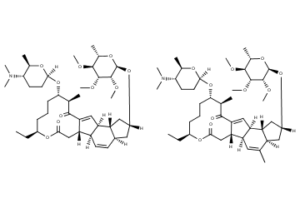Spinosad CAS NO 131929-60-7 Inquire about Spinosad
Tecoland supplies Spinosad bulk active pharmaceutical ingredient (API) to the pharmaceutical industry. Our Spinosad is manufactured by cGMP compliant facility. Welcome to contact us for further details including current DMF status for the product and up to date regulatory status of the manufacturing facility. We look forward to assisting you with your research and development projects.
What is Spinosad?
Spinosad (spinosyn A and spinosyn D) is a new chemical class of insecticides that are registered by the United States Environmental Protection Agency? (EPA) to control a variety of insects. The active ingredient is derived from a naturally occurring soil dwelling microorganism called Saccharopolyspora spinosa, a rare actinomycete reportedly collected from soil in an abandoned rum distillery on a Caribbean Island in 1982 by a scientist on vacation. It has not been found in nature since that time, and was subsequently described as a new species. The bacteria produce compounds (metabolites) while in a fermentation broth. The first fermentation-derived compound was formulated in 1988. Spinosad has since been formulated into insecticides that combine the efficacy of a synthetic insecticide with the benefits of a biological pest control organism.
Spinosad topical suspension, 0.9%, was approved by the U.S. Food and Drug Administration (FDA) on 2011-01-18 for the topical treatment of head lice infestation in patients four (4) years of age and older. It is marketed as the trade name Natroba in the US by ParaPRO Pharmaceuticals. Spinosad is a mixture of spinosyn A and spinosyn D in a ratio of approximately 5 to 1 (spinosyn A to spinosyn D).
Mode of action
Spinosad kills susceptible species by causing rapid excitation of the insect nervous system. Due to this unique mode of action, Spinosad is valued in resistance management programs. Spinosad must be ingested by the insect, therefore it has little effect on non-target predatory insects. It is highly effective used as an oral anti-flea medication for dogs, and apparently has the potential for killing any blood-sucking insect.
Spinosad is relatively fast acting. The insect dies within one to two days after ingesting the active ingredient. There appears to be 100% mortality.
Use
It is used to control a variety of insect pests, including fruit flies, caterpillars, leafminers, thrips, sawflies, spider mites, fire ants, and leaf beetle larvae. Spinosad is recommended for use in an Integrated Pest Management program for commercial greenhouses since it will not harm most beneficial insects or predatory mites. Spinosad does not significantly affect beneficial organisms including ladybugs, green lacewings, minute pirate bugs, and predatory mites. It has also been tested, with promising results, as a mosquito-control agent in West Africa and Israel.
Safety
Its “Caution” signal word indicates a reduced risk to applicators and workers. There are no specific worker protection requirements, even though applicators and handlers should wear a long-sleeved shirt, long pants, shoes and socks.
Spinosad shows low toxicity when ingested by mammals (male rat LD50 = 3738 mg/kg) and no additional adverse effects from chronic exposure. Studies on spinosad show slight toxicity to birds, moderate toxicity to fish, and slight to moderate toxicity to aquatic invertebrates. However, it is highly toxic to bees (honey bee LC50 = 11.5 ppm) and is highly toxic to oysters and other marine mollusks. Applications to areas where bees are actively foraging should be avoided. After the residues have dried, it is much less toxic to bees.
It is important to note that toxicity is based on the active ingredient tested; formulations of spinosad in common use today have a very small amount of spinosad active ingredient. In addition, non-target sensitivity is mitigated by the environmental characteristics of spinosad, including rapid dissipation in the water column, sorption and binding of residues with sediment and lack of bioaccumulation in living tissues.
Beneficial Trichogramma and Braconid wasps are harmed by the chemical, but it has much less effect on such insects as lacewings and beetles like the ladybug and spares predatory bugs such as damsel bugs and the big-eyed bug.
Spinosad does not have any phytotoxicity on ornamentals and is non-phytotoxic for most crops.[citation needed] It has a 4-hour Worker Protection Standard reentry interval (REI).
Do not apply Spinosad more than 10 times in a 12-month period inside a greenhouse to prevent possible insect pesticide resistance.
Disclaimer:
Information on this page is provided for general information purposes. You should not make a clinical treatment decision based on information contained in this page without consulting other references including the package insert of the drug, textbooks and where relevant, expert opinion. We cannot be held responsible for any errors you make in administering drugs mentioned on this page, nor for use of any erroneous information contained on this page.